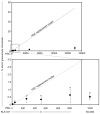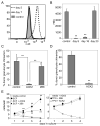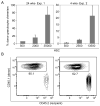Efficient transplantation via antibody-based clearance of hematopoietic stem cell niches
- PMID: 18033883
- PMCID: PMC2527021
- DOI: 10.1126/science.1149726
Efficient transplantation via antibody-based clearance of hematopoietic stem cell niches
Abstract
Upon intravenous transplantation, hematopoietic stem cells (HSCs) can home to specialized niches, yet most HSCs fail to engraft unless recipients are subjected to toxic preconditioning. We provide evidence that, aside from immune barriers, donor HSC engraftment is restricted by occupancy of appropriate niches by host HSCs. Administration of ACK2, an antibody that blocks c-kit function, led to the transient removal of >98% of endogenous HSCs in immunodeficient mice. Subsequent transplantation of these mice with donor HSCs led to chimerism levels of up to 90%. Extrapolation of these methods to humans may enable mild but effective conditioning regimens for transplantation.
Figures




References
-
- Ferry C, Socie G. Exp Hematol. 2003 Dec;31:1182. - PubMed
-
- Buckley RH, et al. N Engl J Med. 1999 Feb 18;340:508. - PubMed
-
- Tjonnfjord GE, Steen R, Veiby OP, Friedrich W, Egeland T. Blood. 1994 Nov 15;84:3584. - PubMed
-
- Muller SM, Kohn T, Schulz AS, Debatin KM, Friedrich W. Blood. 2000 Dec 15;96:4344. - PubMed
Publication types
MeSH terms
Substances
Grants and funding
LinkOut - more resources
Full Text Sources
Other Literature Sources
Medical

